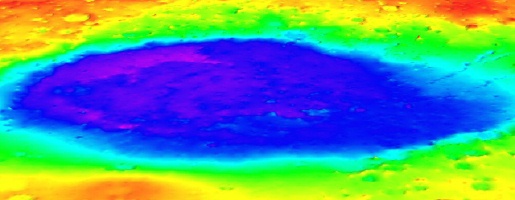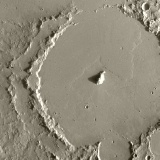 |
||
|
The
topography of the Hellas impact basin, coloured by height.
|
||
| THE CRATERS OF MARS | ||
| The density of impact craters on the Martian highlands is close to that of the cratered regions on the Moon and Mercury. The crater density therefore indicates that the highlands survive from the end of the heavy bombardment, (3.8 thousand million years ago). | ||
| Impact craters on Mars range in size from small pits to large basins rings over 200 kilometres across. At first glance they resemble impact craters found on the Moon or Mercury, with a raised rim, a low floor, and an apron or mantle of debris or ejecta thrown outward by the impact.There are three main types of crater : bowl, rampart, and pedestal. Rampart and pedestal craters are perhaps unique to Mars. The small craters or bowls are like small craters found on rocky planets throughout the Solar System. The larger rampart and pedestal craters are far more interesting. | ||
| Rampart craters | ||
| Rampart craters are distinguished by their ejecta. It covers the surrounding terrain in a thick layer or sheet with a steep ridge at its margin. Craters with diametres in the range of 5 to 10 kilometres have a single ejecta sheet extending one crater radius from the rim, but larger craters frequently have more than one ejecta sheet, with over-lapping lobes. The margins and surfaces of the ejecta are far more complex. There are rows of pits, hummocky terrain, and sometimes thin grooves which radiate from the crater rim. | ||
 Belz, a typical rampart crater in Chryse Planitia. |
||
| Pedestal craters | ||
| Pedestal craters in most respects are quite normal looking craters - they have sharp well defined rims and a low interior. They don't appear very special at all except that they occupy a broad, circular plateau, sometimes half a crater radii, sometimes much larger. The pedestal doesn't look like ejecta, they often have convex margins and can be quite thick. | ||
 Pedestal craters on the northern plains of Mars. |
||
| Pedestals are not distributed evenly on Mars. Most are seen in the northern hemisphere between 30oN and 70oN . Some occur in flat terrain. If water was abundant on the surface it is possible that a shallow lake may have gently eroded away the original surface leaving behind plateaux with craters at their centre. The tear-drop shaped islands carved by fast flowing water show that cratered terrain is more resistant to erosion than the surroundings. | ||
| Other craters | ||
| Some Martian craters differ in another way. Instead of a central hill or peak, they have a central pit. In the first stage of formation, a peak rebounds from the centre of the crater. Because the surface contains water ice, the surface behaves more like soft plastic than rock and rebound drives the material down into the surface forming a central pit. Other craters have been buried, or partially filled, by flowing lava. Pickering crater, for example, clearly shows where lava has breached the crater rim and then flowed into the crater's interior. | ||
 Pickering's interior has been flooded with lava. |
||
| Craters on Mars show how varying target properties determine the shape of the crater which is formed by an impact. Martian craters, with splodgy ejecta and central pits, indicate that at some point in the planet's history there was underground ice and possibly even liquid water. The poor preservation state of many Martian craters is thought by some to indicate that they were degraded by water on the surface. | ||
 The 18 kilometre wide impact crater Yuty surrounding by ejecta. |
||
| Impact basins | ||
| The oldest recognisable features on Mars are the impact basins. Mars has over a dozen, the largest of which is the Hellas impact basin. Hellas is the largest impact basin in the Solar System, with a diameter of 2000 kilometres. Isidis has a diameter of 1900 kilometres, and Argyre 1200 kilometres. There are many other impact basins in the 200 to 800 kilometre diameter range. | ||
 The topography of the Hellas impact basin, coloured by height. |
 The Schiaparelli impact basin, 470 kilometres wide. |
|
|
|
||